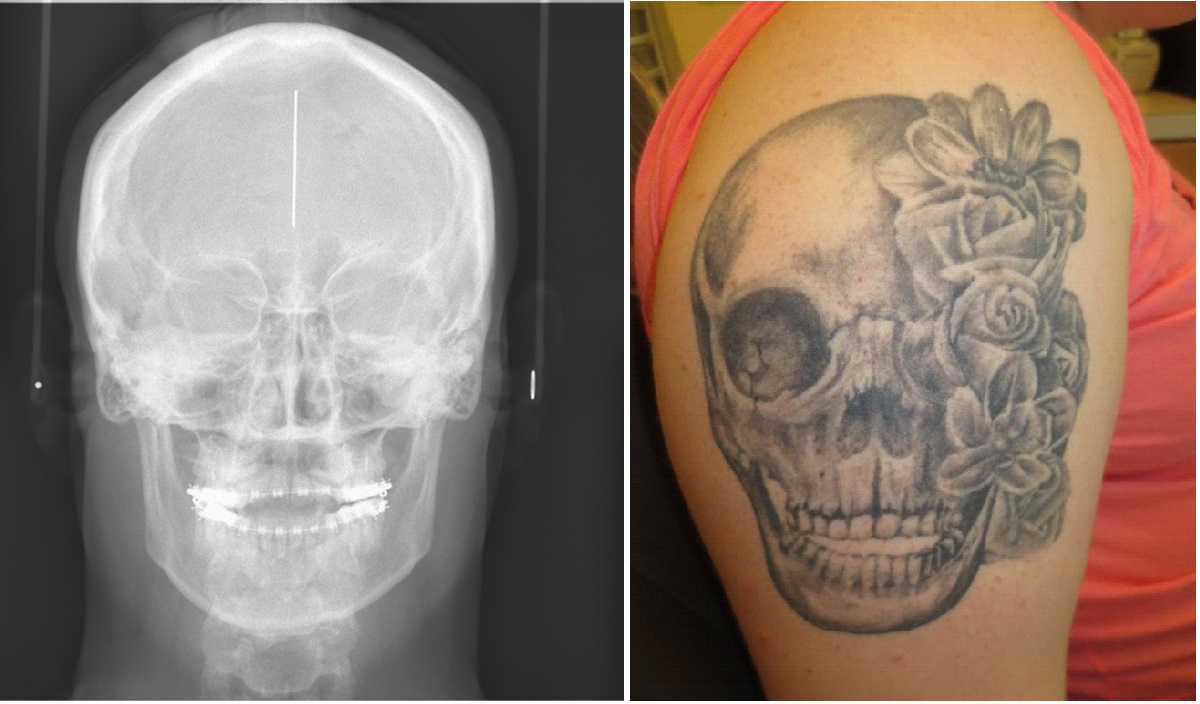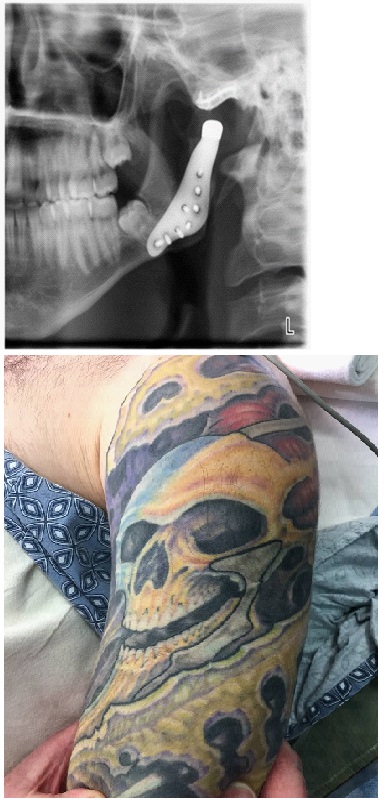
Journal of Clinical Images and Medical Case Reports
ISSN 2766-7820
Case Report - Open Access, Volume 2
Tattoo art imitates life
David A Keith1*; Katherine P Klein2
1 Oral and Maxillofacial Surgeon, Massachusetts General Hospital, Professor of Oral and Maxillofacial Surgery, Harvard School of Dental Medicine, Boston, MA, USA.
2 Assistant Professor of Oral and Maxillofacial Surgery, Massachusetts General Hospital Dental Group, Harvard School of Dental Medicine, Boston, MA, USA.
*Corresponding Author : David A Keith
Oral and Maxillofacial Surgeon, Massachusetts
General Hospital, Professor of Oral and Maxillofacial
Surgery, Harvard School of Dental Medicine, Boston,
MA.
Email: dkeith@mgh.harvard.edu
Received : Mar 25, 2021
Accepted : Apr 29, 2021
Published : May 04, 2021
Archived : www.jcimcr.org
Copyright : © Keith DA (2021).
Abstract
Body art has been part of our culture for centuries and has been used for decorative and symbolic reasons. Less common is the representation of the patient’s own anatomy or surgical procedures. Two recent patients have presented with this phenomenon.
Keywords: Tatoo; Jaws.
Citation: Keith DA, Klein KP. Tattoo art imitates life. J Clin Images Med Case Rep. 2021; 2(3): 1104.
Introduction
Tattooing has a long and varied history and has been practiced across the world from Neolithic times [1]. Tattoos fall into three main categories, the purely decorative, symbolic and pictorial. As a sub-type “Medical” tattoos have been used in radiotherapy and to document medical information such as blood type and medical diagnosis as well as in breast reconstruction and to cover areas of vitiligo [2]. Skulls, faces and other anatomical parts are frequently used decoratively, and a cursory review of web-based resources demonstrate a wide range of styles and designs. A more thoughtful approach to this subject has been published by Emily Evans, an anatomist and medical illustrator. Her book “The Anatomical Tattoo” [3] documents the history of anatomical tattoos and how various organ systems have been depicted. The skull and facial bones are again prominently represented with images sliced, disarticulated and in various states of dental decay and edentulism. An image representative of a medical condition is a tattoo of the vertebrae copied from a radiograph onto the back of a patient with scoliosis. The tattoo closely represents the anatomic deformity. The recipient of this tattoo states “I wanted this tattoo for years as a symbol of my radical acceptance of my body and to help me come to terms with the deformation of my skeletal structure, which has been a mental and physical challenge for me since I was 12. Now I have this tattoo, it’s like a celebration of my flaws”. We have not found any examples of malocclusion or temporomandibular total joint replacement implants tattooed on the skin of patients with these conditions. We report two cases.
Case 1
27-year-old female who has a marked anterior open bite with a vertical gap between her front teeth. The tattoo illustrates accurately her skeletal discrepancy (Figure 1). She denied asking the tattoo artist to reproduce her bite and was unaware of the details of the tattoo. Her malocclusion has been corrected with combined orthodontics and surgery.
Case 2
21-year-old male who has undergone left temporomandibular joint replacement with TMJ Concepts (Ventura, CA.) total joint prosthesis for degenerative arthritis. His tattoo is less accurate but still recognizable (Figure 2).
References
- Deter-Wolf, Aaron. The Material Culture and Middle Stone Age Origins of Ancient Tattooing. Tattoos and Body Modifications in Antiquity: Proceedings of the sessions at the EAA annual meetings in The Hague and Oslo, 2010/11. Zurich Studies in Archaeology. 2013; 9: 15–26.
- Tattoo. Wikipedia https://en.wikipedia.org/wiki/Tattoo accessed 8/30/2018.
- The Anatomical Tattoo. Emily Evans. Anatomy Boutique Books London UK. 2017.


